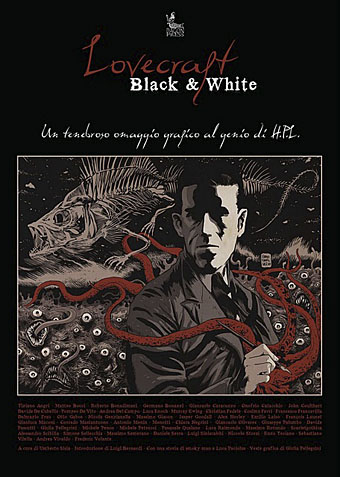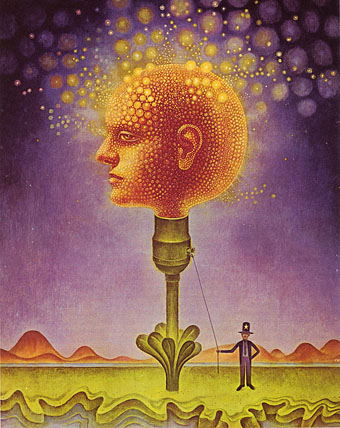Arriving in the post this week was Lovecraft Black & White, an Italian book whose contents are spelled out in the title, black-and-white illustrations based on the work of the Providence master. Among the featured works is my 1999 rendering of Azathoth. There’s more about the book here and here.
Also on the work front, one of the books I designed interiors for a couple of months back was The Search for Philip K. Dick, a sombre biography and memoir by Anne R. Dick, the author’s third wife. Ms Dick discussed the book with the NYT a few days ago. The design was mostly straightforward layout but I did make a quick ASCII portrait of PKD from one of Anne Dick’s photos.
• Farewell, the documentary film about Lady Grace Drummond-Hay’s flight around the world in the Graf Zeppelin, can be viewed here.
• “I personally think that the pages look better on the iPad than they do in real life.” Artist Tom Phillips again on the Humument iPad app.
• The Birds Are Flying Elsewhere: singer/songwriter Linda Perhacs. Related: Parallelograms – A Short Film About Linda Perhacs.
• St Eia, guitar improvisations by Zali Krishna, “Keywords: jazzgazing; entropy circus; st ives; cornwall; psychogeography”.
• Moon Wiring Club and DD Denham: music for children, by children. Related: Moon Wiring Club’s Jayston Mix.
The 1970s was another country, they did things differently there. One of a number of illustrations for science textbooks by Phil Kirkland at A Journey Round My Skull.
• “Fellatio has become a recurrent theme in your work hasn’t it, I say.” Alan Bennett sheds some inhibitions.
• Talking To The Sci-Fi Lord: Regenerations & Ruminations With Michael Moorcock.
• Time and the Gods (1906) by Lord Dunsany, illustrated by Sidney Sime.
• City of Silence, a calendar for 2011 by Thom Ayres.
• Scientists glimpse universe before the Big Bang.
• Photography by Josef Sudek (1896–1976).
• Aurora photo gallery, November 2010.
• Parallelograms (1970) by Linda Perhacs | Six AM (1979) by Thomas Leer & Robert Rental | Rockin’ Back Inside My Heart (1989) by Julee Cruise.



I used to be in the Philip K Dick society long before the internet made the puclication of their Newsletter redundant and remember the photo your illustration is based on being prominent in one of the issues. Interesting that she still kept his surname.
His second wifes daughter is still trying to get her biography of him published
http://www.annemini.com/?page_id=785
I’m a great fan of HPL, and among the innumerable artists who illustrated his tales I give my preference to Alberto Breccia (and his comics based upon the Cthulhu Myths), and then Santiago Caruso (here you can watch the complete illustrations for The Dunwich Horror: http://www.youtube.com/watch?v=vzkExCaJFVk) and, last but not least, The Haunter of the Dark by JC… ;-)
I think Lovecraft is a writer most difficult to illustrate, and it is also very hard to avoid a certain ridiculousness and absurdity when one try to fix the haunted charms of a Lovecraft’s tale in a simple drawing and this is the problem for the most part of his illustrators.
Some old stuff about PKD
http://www.newyorker.com/arts/critics/books/2007/08/20/070820crbo_books_gopnik?currentPage=all
and Anne’s reaction to this article:
http://totaldickhead.blogspot.com/2007/09/anne-dick-responds-to-new-yorker.html
Gabriel: I found time to update my book design pages today so I’ve added the PKD book here.
Thanks, Andrea, I’d not seen that work before. There’s been an explosion of Lovecraft illustration in recent years, that’s one of the many reasons I feel little inclination these days to add to it. If I wasn’t preoccupied with my own projects I might pursue a few ideas. Some of the imagery has become rather stale and lacks the sense of indistinct weirdness that’s at the heart of many Lovecraft stories. Too many tentacles, not enough original vision. And I’m sick of all that furry Cthulhu shit, Americans seem intent on infantilising every last thing. Caruso’s work is good, however, although I’m biased towards Breccia’s version of that story, it knocked me out when I first saw it.
Thanks but you have to fix the “here” link above. It doesn’t take you to
http://www.johncoulthart.com/bibliopoesy/pkd.html
at the moment
Nice minimalism in the fonts used from the scans you’ve posted.
It doesn’t seem to be available here yet in the land of Oz.
Might try and order a copy from the best book store in Sydney
http://bookweb.kinokuniya.co.jp/indexohb.cgi?AREA=06
Found a big online version of the photo with cat
http://www.philipkdick.com/aa_g-fame-cat.html
Thanks, link is fixed. That was odd, I remember pasting it in earlier.
I used a typewriter font for the Dick book, mainly because the cover had been designed first so I was following that style.